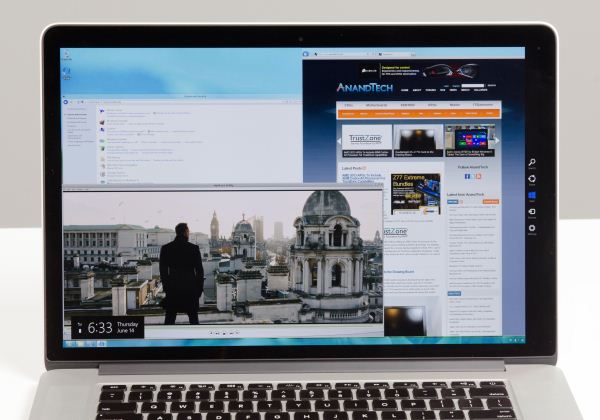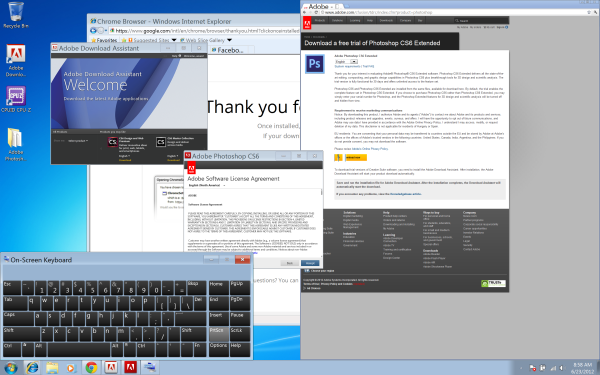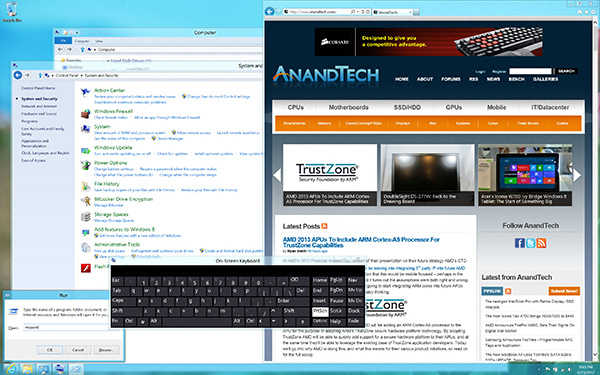The next-gen MacBook Pro with Retina Display Review
by Anand Lal Shimpi on June 23, 2012 4:14 AM EST- Posted in
- Mac
- Apple
- MacBook Pro
- Laptops
- Notebooks
Boot Camp Behavior
When the MacBook Pro with Retina Display first started shipping Apple hadn’t even released Boot Camp drivers for the system. Since then Apple has uploaded a Windows Support package to its servers, and the Boot Camp Assistant will give you drivers for everything in the machine should you ask for it.
The driver bundle and Boot Camp Assistant work with both Windows 7 and the Windows 8 Release Preview, although Apple only explicitly offers support for the former. You don’t have to do anything to make the Windows 8 RP work with the Boot Camp Assistant, just supply the Win 8 RP ISO instead of the Windows 7 image during the Boot Camp setup and you’re all set.
Like all previous MacBook Pro Boot Camp installs, only the discrete GPU is “connected” under Windows. Apple relies on a lot of its own software to switch between processor and discrete graphics which obviously isn’t made available under Windows, thus you only get the dGPU. Apple uses NVIDIA’s 296.49 drivers for the GeForce GT 650M under Windows. Since the standard Windows desktop doesn’t support integer DPI scaling (see update below as you can force 2.0x scaling) Apple picked the next best option and configures Windows for 1.5x DPI scaling and 2880 x 1800 as the defaults. The result is a desktop that looks like this:
At the largest text scaling setting Windows is remarkably usable on the 15.4-inch display at 2880 x 1800. Unfortunately as I mentioned in the Zenbook Prime review, Windows 7 and third party handling of DPI scaling is hardly elegant. While applications that aren’t Retina-aware under OS X tend to simply have blurry text, those that don’t behave properly with DPI scaling under Windows just look odd. Some text elements will be huge and overflow outside of their normal borders, while others will ignore the scaling setting entirely and just be too small. It’s passable in a pinch but suboptimal for certain.

Windows 8 RP on the rMBP. Note the Skyfall trailer is in a full 1080p window
Windows 8 does a somewhat better job, but only under Metro. Metro supports integer DPI scaling at 1 and 2x factors, similar to OS X. With DPI scaling enabled under Windows 8, Metro looks like it would at 1440 x 900 - similar to the default setting for the Retina MacBook Pro under OS X.

200% DPI scaling under Windows 7
Update: As many of you have correctly pointed out, Windows allows you to specify custom DPI scaling modes including an integer 2.0 setting. The result is the same "1440 x 900"-like desktop you get under OS X. Application compatibility still appears to be an issue, check out the gallery below for some examples. Overall Windows is very usable on the rMBP, but just as under OS X the overall experience really depends on application support.
Software Funniness
With the Retina MacBook Pro I get the distinct impression it was launched before the software was ready to support it. Apple did an amazing job enabling Retina support in all of the iLife applications, but iWork isn’t ready for it yet. The system technically launched without Boot Camp support although that was soon added. Then there are the UI performance issues in applications like Safari under the currently available version of Lion. There are also occasional graphical glitches under Lion. the occasional flashing of UI elements, nothing major but just not the polish we’re used to from Apple. Once again, Mountain Lion addresses a lot of this and is only a month out but you still have to deal with reality in the interim.
I also had a strange experience where the CPU clocks on the system magically decided to get clamped down to around 1.2GHz on battery power. A simple reset of the PRAM and SMC fixed the problem but it was odd behavior for sure. I can’t completely fault Apple for this one, as I know I subjected the rMBP to a bunch of strange tests over the course of the past week and a half.
If you’re buying today, just be aware that the best experience will come with Mountain Lion and even then you’ll have to wait an unspecified amount of time for Retina-aware app updates.























471 Comments
View All Comments
RaygunV - Sunday, June 24, 2012 - link
Apple has done nothing. Higher resolutions were already in the pipeline before apple released theirs. Apple releases first only so that the public DOES think they are innovative.Apple has done nothing special, just using maturing technology like all vendors will.
http://www.tomshardware.com/news/Intel-Higher-Reso...
designerfx - Sunday, June 24, 2012 - link
the same as apple: improving on plenty of things while missing the boat.apple: lack of improvements on hardware (not their fault, but raising resolution without a substantially more powerful GPU = things tend to suck if you try to take advantage of the resolution).
Note all the benchmarks at the scaled down resolution on the GPU testing. You don't even want to know what these games will run at with 28xx by 18xx.
If 1680x1050 is achieving 60fps, it's not hard to guess that 15fps might be an optimistic answer at 2800x1800.
Meanwhile, all this "Scale the appropriate elements while letting the rest display full resolution" is an important part of the OS that windows 8 probably will miss, entirely.
Spunjji - Monday, June 25, 2012 - link
Sony, Vaio Z, 13" 1920x1080. Thanks, Apple? :|starburns - Monday, June 25, 2012 - link
http://en.wikipedia.org/wiki/Ultra_High_Definition...Super resolutions have been around since 2005, this retina display is still only half the resolution that other companies have achieved years ago.
KitsuneKnight - Saturday, July 7, 2012 - link
Displays that cost enough to buy 5+ of these laptops (if you find them on firesale!). Not really comparable.optics261 - Saturday, June 23, 2012 - link
One review to rule them all!zappb - Saturday, June 23, 2012 - link
With 4k resolution screens to bind them. Apple=progress (finally).After years of ignoring screen quality Lenovo, dell, hp....thanks pingguo.
yhselp - Saturday, June 23, 2012 - link
One Review to rule them all, One Review to show them, One Review to teach them all and in the darkness more objective make them.eron - Saturday, June 23, 2012 - link
What software was used to measure the frame rate?Spoony - Saturday, June 23, 2012 - link
Quartz Debug. Part of Apple's developer tools. There is a string you can use to expose additional functionality in Quartz Debug such as resolution scaling factor and manual GPU switching.$ defaults write com.apple.QuartzDebug QuartzDebugPrivateInterface -boolean YES